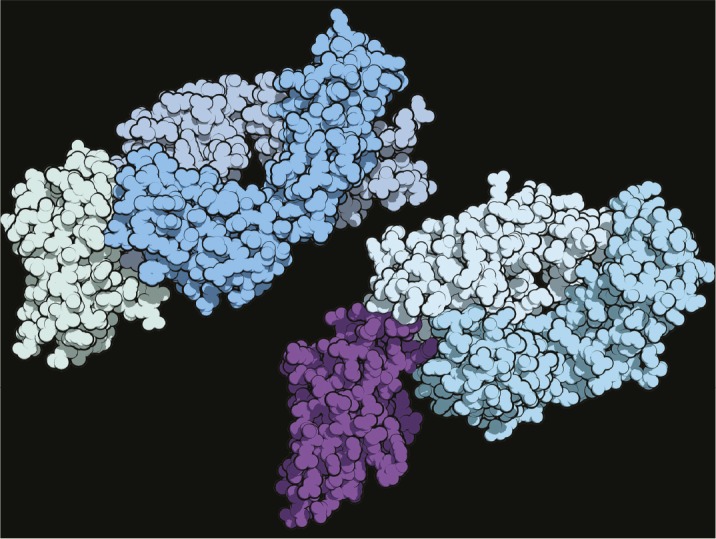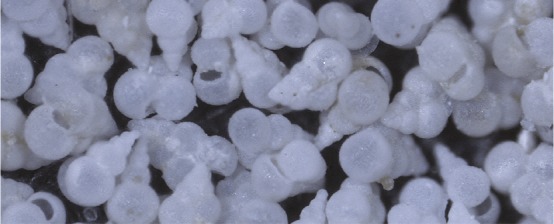Comparing single and combined agents in cancer immunotherapy

Anti–CTLA-4 (Left) and anti–PD-1 (Right) antibodies. Images courtesy of Wikimedia Commons/Fvasconcellos.
More than 250 combination immunotherapies in which a pair of agents simultaneously target the immune checkpoint molecules cytotoxic T lymphocyte antigen-4 (CTLA-4) and programmed cell death-1 (PD-1) are in clinical trials for cancer. However, whether combination immunotherapies, which outperform monotherapies in prolonging survival in some cancers, deploy similar therapeutic mechanisms as monotherapies remains unclear. Spencer Wei et al. (pp. 22699–22709) used mass cytometry-based methods to examine genetically comparable tumors from mice treated with anti–CTLA-4 antibodies, anti–PD-1 antibodies, or both antibodies. Computational analysis of immune cell populations in tumor infiltrates revealed that anti–PD-1 monotherapy led to expansion of an exhausted CD8+ T cell subset, whereas anti–CTLA-4 treatment had no effect. Following combination therapy, the numbers of exhausted CD8+ T cells were significantly reduced. By contrast, activated effector CD8+ T cells increased following combination therapy but not after anti–PD-1 monotherapy. Compared with anti–CTLA-4 monotherapy, combination therapy led to a greater increase in the frequency of a subset of CD4+ effector T cells, despite the observation that anti–PD-1 alone had no effect on that subset. Whereas both monotherapies diminished subsets of regulatory T cell (Tregs), which can inhibit tumor immune response, combination therapy showed an additive effect in tamping down Tregs. Comparison of peripheral blood samples from patients with metastatic melanoma previously treated with anti–CTLA-4 monotherapy, anti–PD-1 monotherapy, or combination therapy revealed an increase in terminally differentiated CD8+ T cell frequency following combination therapy. Additional experiments revealed that peripheral blood analysis can provide mechanistic insights into therapies but is insufficient to fully characterize treatment-induced antitumor immune responses. The findings indicate the need for preclinical studies and large prospective trials to tease apart the therapeutic mechanisms specific to combination immunotherapies, according to the authors. — P.N.
Early placental cells and pregnancy success
Many pregnancies fail early in human embryo development, before or during implantation. Relatively little is known about the molecular and cellular mechanisms underlying placenta formation and implantation of the embryo into the uterine wall. Rachel West, Hao Ming, Deirdre Logsdon, et al. (pp. 22635–22644) performed single-cell RNA sequencing of human trophoblast (TB) cells that make up the early placenta on days 8, 10, and 12 after fertilization—a time corresponding to the first 5 days after the embryo begins to implant into the uterine wall. During this period, proliferating progenitor stem cells, called cytoTB cells, gave rise to 2 distinct sublineages, syncytioTB (STB) and migratoryTB (MTB) cells. STB cells expressed genes involved in producing placental hormones, which may help ensure successful continuation of the pregnancy. The motile MTB cells expressed genes that play a role in migration and invasion, which may facilitate embryo implantation. In addition, the MTB cells expressed genes associated with interferon signaling, which has a well-known role in defending against pathogens and may affect embryo survival. According to the authors, the findings illustrate how the molecular cross-talk between mother and early placental cells determines pregnancy success and reveals mechanisms that facilitate human implantation. — J.W.
Evolutionary history of butterflies and moths

The mapwing butterfly, Cyrestis thyodamas.
Butterflies and moths, which constitute the insect order Lepidoptera, are thought to have coevolved with flowering plants and echolocating bats, respectively, but this hypothesis has not been tested due to the lack of a sufficiently robust dated evolutionary tree for Lepidoptera. Akito Kawahara et al. (pp. 22657–22663) developed such a tree using more than 2,000 protein-coding gene sequences from 186 extant lepidopteran species and calibrated the timing of various radiations using a set of carefully evaluated fossils. The results indicate that the most recent common ancestor of all extant Lepidoptera dates to the Late Carboniferous Period, approximately 300 million years ago, considerably earlier than hypothesized. The nectar-feeding proboscis, a feature thought to have promoted butterfly and moth diversification, appeared approximately 240 million years ago in the Middle Triassic Period, coincident with the likely diversification period of flowering plants. The authors identified multiple separate origins of hearing organs in nocturnal moths, several of which predate the emergence of echolocating bats by millions of years. The results support the hypothesis that Lepidoptera diversified concurrently with flowering plants, but do not support the hypothesis that moth hearing organs evolved in response to echolocating bats, according to the authors. — B.D.
Trait-like individual variations in brain organization
In studies that examine human brain function, data are often averaged across individuals. However, past research has revealed variation in patterns of brain activity across individuals. Benjamin Seitzman, Caterina Gratton, et al. (pp. 22851–22861) report that individual-specific deviations in functional networks, called network variants, show stable, trait-like patterns that relate to high-level cognitive functions as well as neuropsychological attributes. The authors compared individual- and group-averaged resting-state activity, which refers to brain activity when no explicit task is being performed, from 4 functional magnetic resonance imaging (fMRI) datasets collected from 514 individuals. All participants had at least 1 network variant, and the variants were stable across sessions within individuals. Variants in the default mode network showed the expected reduction in activation during visual and semantic tasks, consistent with the known functional properties of this network. In addition, the findings revealed 2 subgroups of individuals whose network variants had distinct functional properties. The subgroups also differed in neuropsychological measures of life satisfaction and drug abuse history, suggesting that network variants may relate to behavior. Taken together, the findings suggest that group-level fMRI results may not accurately reflect the brain activity patterns of individuals. According to the authors, the findings could shed light on individual differences in brain function and behavior across domains. — J.W.
Ocean acidification and Cretaceous–Paleogene mass extinction

Heterohelix globulosa foraminifera isolated from the K–Pg boundary clay at Geulhemmerberg, the Netherlands, shown at 8x magnification.
The Cretaceous–Paleogene (K–Pg) mass extinction, which occurred 66 million years ago, coincides with the Chicxulub asteroid impact and intense volcanic activity in the Deccan Traps. Little empirical evidence exists for the specific mechanism by which either of these factors could have contributed to the mass extinction. Michael Henehan et al. (pp. 22500–22504) measured boron isotope ratios, a proxy for ocean pH, in fossil marine microorganisms from before, during, and after the K–Pg boundary. The data indicate that a rapid pulse of ocean surface acidification occurred immediately following the Chicxulub impact, suggesting a mechanism for mass extinction in the oceans. This pulse was followed by a rapid pH rebound and overshoot caused by the selective extinction of calcifying marine organisms and prompted a major disruption of the global carbon cycle. Earth system model simulations suggested that ocean carbon isotope and pH patterns observed after the K–Pg boundary were consistent with a 50% reduction in global marine primary productivity. The authors suggest that the reduction in global primary productivity lasted up to 40,000 years. However, even after productivity began to recover, the ecological aftermath of extinction continued to affect Earth’s carbon cycle through inefficient carbon export from the surface to the deep sea. Furthermore, the absence of prolonged ocean surface acidification suggests that increased volcanism played a minor role, if any, in driving the mass extinction. — B.D.


